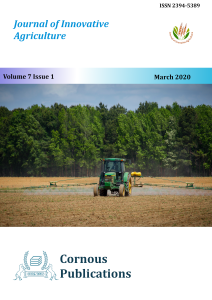
Journal of Innovative Agriculture
Peer Reviewed Open Access Journal
ISSN: 2394-5389 NAAS Rate: 4.05
Submit Manuscript
Peer Reviewed Open Access Journal
ISSN: 2394-5389 NAAS Rate: 4.05
Submit ManuscriptThe yellow stem borer (YSB) Scirpophaga incertulas (Walker) (Pyralidae: Lepidoptera) is one of the major pests in rice producing areas and accounts for 27 to 34 per cent loss in the crop yield. Climate change especially temperature increase will affect the insect physiology, behavior and development. An investigation was undertaken to study the effect of temperature on Scirpophaga incertulas (Walker) by constructing the stage specific life table to understand its behaviour in the future climate. Experiments were carried out at four different temperature regimes viz., 28.0°C, 30.0°C, 32.0°C and 34.0°C. The results revealed that the survival fraction of a particular stage reduced with increasing temperatures. The calculated apparent mortality indicated that the percentage of insect died, increased with increasing temperatures. The results showed that the Mortality Survival Ratio (MSR) was observed to be increasing with increasing temperatures for all the stages. The value of IM was observed to be decreasing with increasing temperatures. The generation mortality of YSB was increasing with increase in temperatures for all the stages. The experiments revealed that the insects which happened to live under higher temperature would die faster and most of their energy is spent for reproduction rather than for living long time.
climate change, global warming, life table, plant protection, temperature, yellow stem borer
Arshad, A., & Rizvi, P. Q. (2009). Life table studies of Menochilus sexmaculatus Fabr.(Coleoptera: Coccinellidae) at varying temperature on Lipaphis erysimi Kalt. World Applied Sciences Journal, 7(7), 897-901.
Ali, A., & Rizvi, P. Q. (2010). Age and stage specific life table of Coocinella septemounctata (Coleoptera: Coccinellidae) at varying temperature. World Journal of Agricultural Sciences, 6(3), 268-273.
Aziz, M. A., Iftkhar, A., & Hanif, M. (2013). Life table studies of Trilocha virescence (Bombycidae: Lepidoptera) on Ficus nitida. Asian J Agri Biol, 1(1), 2-7.
Bale, J., Masters, G., Hodkinson, I., Awmack, C., Jnbezemer, T.M., Brown, V.K., Butterfield, J., Buse, A., Coulson, J.C., Farrar, J., Good, J.G., Harrington, R., Hartley, S., Jones, T.H., Lindroth, L., Press, M., Mrnioudis, I., Watt, A. & Whittaker, A. (2002). Herbivory in global climate change research: direct effects of rising temperature on insect herbivores. Global Change Biology, 8, 1-16.
Butler, G. D. (1982). Development time of Coccinella septempunctata in relation to constant temperatures [Col.: Coccinellidae]. Entomophaga, 27(3), 349-352.
Carey, J. R. (1993). Applied demography for biologists: with special emphasis on insects. Oxford University Press.
Carey, J. R. (2001). Insect biodemography. Annual review of entomology, 46(1), 79-110.
Huesing, J., & English, L. (2004). The impact of Bt crops on the developing world.
IPCC. (2019). Summary for Policymakers. In: Climate Change and Land: an IPCC special report on climate change, desertification, land degradation, sustainable land management, food security, and greenhouse gas fluxes in terrestrial ecosystems. (Eds. P.R Shukla, J Skea, E.C Buendia, V.M Delmotte, H.O Pörtner, D.C Roberts, P Zhai, R Slade, S Connors, R van Diemen, M Ferrat, E Haughey, S Luz, S Neogi, M Pathak, J Petzold, J.P Pereira, P Vyas, E Huntley, K Kissick, M Belkacemi and J Malley). pp. 1-41. IPCC.
Iranipour, S., Kharrazi Pakdel, A., & Radjabi, G. (2010). Life history parameters of the Sunn pest, Eurygaster integriceps, held at four constant temperatures. Journal of Insect Science, 10(1), 106.
Katsarou, I., Margaritopoulos, J. T., Tsitsipis, J. A., Perdikis, D. C., & Zarpas, K. D. (2005). Effect of temperature on development, growth and feeding of Coccinella septempunctata and Hippodamia convergens reared on the tobacco aphid, Myzus persicae nicotianae. BioControl, 50(4), 565-588.
Manikandan. N., Kennedy, J.S. & Geethalakshmi, V. (2014). Life history and population dynamics of rice leaffolder at different temperatures. Ecoscan., 8(3&4), 315–320.
Menéndez, R. (2007). How are insects responding to global warming?. Tijdschrift voor Entomologie, 150(2), 355.
Pervez, A. (2004). Temperature‐dependent development and immature survival of an aphidophagous ladybeetle, Propylea dissecta (Mulsant). Journal of Applied Entomology, 128(7), 510-514.
Rai, M. K., Ramamurthy, V. V., & Singh, P. K. (2002). Biological attibutes and Morphometrics of Coccinella septempunctata (Linnaeus)(Coccinellidae: Coleoptera). Annals of Plant Protection Sciences (India).
Sarwar, M. (2011). Effects of Zinc fertilizer application on the incidence of rice stem borers (Scirpophaga species)(Lepidoptera: Pyralidae) in rice (Oryza sativa L.) crop. Journal of Cereals and Oilseeds, 2(1), 61-65.
Sarwar, M., Akbar, A., Ahmad, N., Khan, G.Z., Bux, M. & Tofique, M. (2007). Field Performance of Systemic Foliar and Granular Insecticides against Rice Stem Borers (Scirpophaga spp) in Rice Crop. In: Proceedings of the 26th Pakistan Congress of Zoology, Multan, p.89-94.
Sarwar, M. (2012). Management of rice stem borers (Lepidoptera: Pyralidae) through host plant resistance in early, medium and late plantings of rice (Oryza sativa L.). Journal of Cereals and Oil seeds, 3(1): 10-14.
Saxena, R.C., Medrano, F.G. & Sunio, L.M. (1990). Rearing yellow stem borer (YSB) for screening varietal resistance. IRRN. 15, 15.
Southwood, T.R.E. & Henderson, P.A. (2000). Ecological methods. Blackwell Science.
